Puthuppally native Gijikumar restructured his home bit by bit, with almost all that he could salvage of his old abode. It was a challenge for the owner who was determined to remodel his house without sacrificing anything that went into making the old one.
Tired of and disgusted with termites and leaking roofs, Gijikumar contemplated selling the place. He even thought that building a new house would be economically more viable than renovating his old house.
But memories of growing up there and the happy times spent at the house made him think of redoing the entire structure.
Today, if the house in Puthuppally is akin to old wine in new bottle, then it’s definitely sweeter and truly vintage.
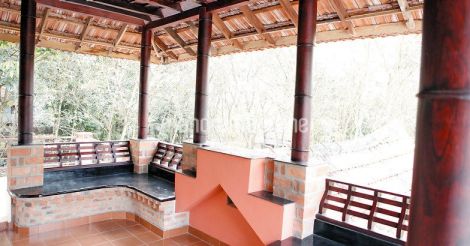 One steps into the formal living room from a small sit-out.
One steps into the formal living room from a small sit-out.With only Rs 1,000 per sq ft going into renovation, the 2,800 sq ft house with its “ara and nira”, stood transformed with the old merging with the new.
The old house had flaws aplenty. For one, all the rooms were small and low-roofed with tiles laid atop. The walls were built with laterite stones. Till recently, the house was host to a joint family. When Gijikumar and his family started living there all by themselves, they realized how difficult it was to maintain the place. The thought of a makeover took shape then.
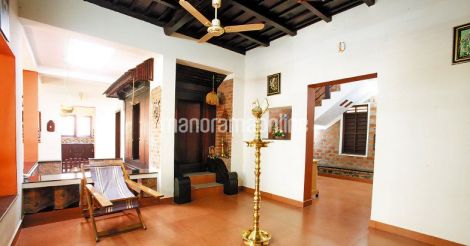 No walls separate the family living and dining sections.
No walls separate the family living and dining sections. Costford engineer, Biju P.John was entrusted with the facelift work. When the designer examined the house, he realized the walls were intact and the foundation, strong. So he decided to retain all the walls outside and knock down a few inside, which would give the house more room and floor space.
A small semblance of a room behind the house had the possibilities of being converted into a full-fledged bedroom. A small sit-out was also planned there and it required hardly any extra floor space. The car porch at the entrance was a new feature. Stones, old wooden doors, windows and all possible material from the old structure were re-used. Only the door at the entrance was newly bought. Even the crumbling plywood from the old dining chairs were removed and replaced by wooden planks from the old house.
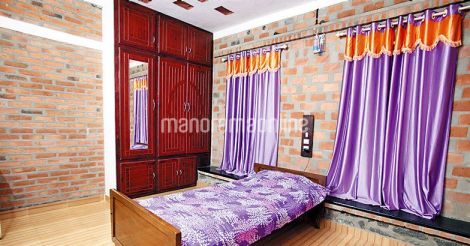 A small semblance of a room behind the house had the possibilities of being converted into a full-fledged bedroom.
A small semblance of a room behind the house had the possibilities of being converted into a full-fledged bedroom.The “designer” pillars of the car porch were made from boundary stones. The stones were cut into small pieces, symmetrically arranged and bound together in cement. Without granite and at half the cost, it looks very trendy. The space above the porch was trussed and tiles were laid.
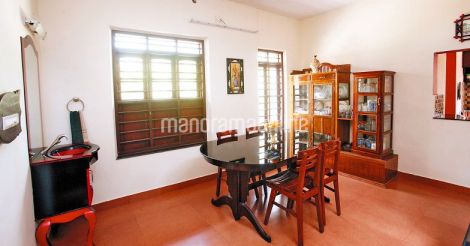 The main attraction of this part of the house is the pool built close to the dining area.
The main attraction of this part of the house is the pool built close to the dining area. One steps into the formal living room from a small sit-out. No walls separate the family living and dining sections. A wall was knocked down and the height of the wooden ceiling raised to give the area an elevated look. The main attraction of this part of the house is the pool built close to the dining area. With a pergola on top and seating built around, it’s an ideal spot to chill out. A natural outlet lets out excess water from the pool when it goes beyond the fixed level.
The old “ara”, polished and retained, was slightly shifted from its original seating. It’s now closer to the pool. A small divan here allows for some rest and it’s been turned into one comfy nook.
The staircase winds up from the newly modeled study room.
The three bedrooms downstairs are the same old ones. The only change was that the main bedroom was extended a bit to give it more room. All bedrooms have inbuilt wall seatings. The master bedroom is not the most spacious one. A store close to the kitchen and a small passage were merged to make a bedroom. Though large and spacious, Vaastu-wise, it was most unsuitable for a master bedroom. The guest room and another small room find place upstairs.
While doing up the kitchen, it was decided to retain the old walls. However, during construction, when one of them collapsed, all the walls were redone. The sprawling old kitchen was made smaller to accommodate a work area.
Here’s the star attraction of Gijikumar’s house. While taking the stairs, you see a large window made of bottles. It was actually a water wheel, which the owner had in mind for the window. Since he did not get one of his choice, he used wood instead to design the window. Much later, when he got a water-wheel, he dressed it up with bottles of many colors and had it installed in the guest room. This room opens out to an attractive balcony. The pillars of the balcony are extra special. When chendas (cylindrical percussion instruments) are made, the wood is cut into cylinders, the mid-portion of which becomes hollow and its wood rendered useless. In this very cost-effective technique, the wood thus rejected was joined together and it’s on these pillars that the sit-out stands.
Cost cutting measures:
Walls and floors, which were intact, were retained. Walls connecting small rooms were knocked down and ceilings raised to give rooms a look of expansiveness.
Wood from the old structure and the “ara” were retained. Wood from rooftop shafts were used for making handrails for the staircase.
Old doors and windows were retained. A lot of laterite stones from the old structure were also used up.
Plastic panels were replaced by wood for switchboards.
Wall-seatings were constructed in bedrooms and the balcony where folks could put up their feet.
Stone slabs came in handy for pillars.
Wooden almirahs were polished and reused.
The septic tank was remodeled to turn it into a biogas plant.

























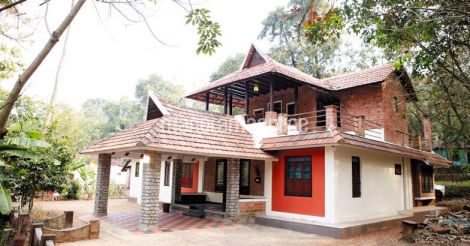 It was a challenge for the owner who was determined to remodel his house without sacrificing anything that went into the making the old one.
It was a challenge for the owner who was determined to remodel his house without sacrificing anything that went into the making the old one.